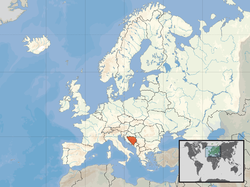Wikijunior Europe: Bosnia-Herzegovina

Bosnia-Herzegovina (also known as Bosnia and Herzegovina) is a country in southern Europe. It shares borders with Croatia, Serbia and Montenegro. Bosnia-Herzegovina consists of two geographic regions - Bosnia (in the north, east and centre) and Herzegovina (in the south west). Bosnia-Herzegovina is divided into two political entities - the Federation of Bosnia-Herzegovina and Republic of Srpska. People who live in Bosnia-Herzegovina are called Bosniak (or Bosnian), Croatian or Serbian. The capital city is Sarajevo (capital of the whole country and the capital of the federation). Banja Luka is the capital of the Republika Srpska state. Other big cities in B&H are Mostar, Tuzla and Doboj. Bosnia-Herzegovina is best known for the brutal conflict in the 1990s and its stunning scenery, cities and mix of different cultures. Bosnia-Herzegovina is not part of the European Union and it uses the Convertible Mark - colloquial name official name international monetary sytem is Bosnian Mark [BAM]as its currency.
History of Bosnia-Herzegovina
editBetween 1918 and 1992 Bosnia-Herzegovina was part of Yugoslavia and received investment from richer parts of the country like Slovenia and Croatia. In 1991 Slovenia and Croatia both became independent. Bosnia-Herzegovina also declared independence with support of majority of its citizens Bosnians/ Bosniaqs, Bosnian Croats and Bosnian Serbs, but this was complicated because smaller part of Bosnian Serbs indoctrinated by the Serbia wanted to remain part of Yugoslavia or eather Great Serbia and so created the Serbian Republic of Bosnia and Herzegovina. Similarly, War soon followed Jugoslavian army at the time 4th European armed force just handover all artillery and weapons to Bosnian Serbs who strtes massive massacres rapings and worst atrocities in Europe after WW2. In 1993 Bosnian Croats wished to become part of newly-independent Croatia and created the Croatian Community of Herzeg-Bosnia.
The Bosnian War between 1992 and 1995 killed around 110,000 people and devastated historic cities like Sarajevo and Mostar and continues to disrupt normal life today because of land mines and ruined houses which pose a hazard to citizens. After the war ended in 1995 the country was divided into two political parts: Republika Srpska - about 49% of the etnicaly cleansed territory with other ethnicities apart of Bosnian Serbs and Federation of Bosnia-Herzegovina - about 51 % of the territory and a mix of Bosniaks and Bosnian Croats. Neither part is independent but they have separate governments, elections, schools and alphabets (Republika Srpska uses the Cyrillic alphabet). The country remains divided today.
Geography of Bosnia-Herzegovina
editThe country's name comes from the two regions Bosnia and Herzegovina, which have a very vaguely defined border between them. Bosnia occupies the northern areas which are roughly four fifths of the entire country, while Herzegovina occupies the rest in the south part of the country. The highest mountain in the country is Maglić at 2,386 metres.
The region of Bosnia is the largest geographic region with moderate continental climate, marked by hot summers and cold, snowy winters. Smaller Herzegovina is the southern tip of the country, with Mediterranean climate and very hot summers that can reach 45 C (around 115 F). Bosnia and Herzegovina has many natural resources. The name of Herzegovina was forced upon Bosnia by Otto Von Bismarck during the Congress of Berlin in 1878. Central Bosnia is the most mountainous part of Bosnia featuring predominate mountains Vlašić, Čvrsnica, and Prenj. Eastern Bosnia also features mountains like Trebević, Jahorina, Igman, Bjelašnica and Treskavica. It was here that the 1984 Winter Olympics were held. Its mascot was Vučko.
People of Bosnia-Herzegovina
editDue to the conflicts in the 1990s, the Bosnian people can be nationalistic and often claim to be Bosniak, Croatian or Serbian. The term 'Bosnian' usually describes people who identifying as Bosnians (Muslim, Catholic or Orthodox).
Bosnia-Herzegovina has 3 major religions. Islam is practiced by around 40-45% of the population, mainly Sunni Islam. Christianity is practiced by around 50% of population: Christian Orthodox is practiced by around 30% of the population and by the majority living in Republika Srpska, while Catholicism is practiced by around 20% of the population of Bosnia-Herzegovina - mainly by Croatians, and it is the main Christian denomination in west Herzegovina.
Sights of Bosnia-Herzegovina
editBosnia and Herzegovina has been a top performer in recent years in terms of tourism development; tourist arrivals have grown by an average of 24% annually from 1995 to 2000. Some of the tourist attractions in Bosnia and Herzegovina include:
- Sarajevo - often described as Europe's Jerusalem because of the mix of churches, synagogues and mosques.
- Banja Luka, the "Green City"
- Bihać and the Una River
- Doboj and its 13th century fortress
- Jajce and its waterfall
- Mount Bjelašnica and Jahorina, sites of the XIV Olympic Winter Games.
- Neum on the coast
- Stolac, the Begovina neighborhood and Radimlja tombstones
- Višegrad and its old bridge (a UNESCO World Heritage Sites)
- Visoko, site of the alleged Bosnian pyramids
- Mostar and the re-built bridge (also a UNESCO World Heritage Site)
- Tešanj, one of the oldest cities in Bosnia with its old town.
In the past few years, Lonely Planet rated Sarajevo as #43 in the list of Best Cities in the World, ahead of other famous cities like Dubrovnik (#59), Ljubljana, Slovenia (#84), Bled, Slovenia (#90) and Belgrade (#113)
| Wikijunior Europe • Intro • EU • Geo • People • Language • Facts • Quiz | edit | ||